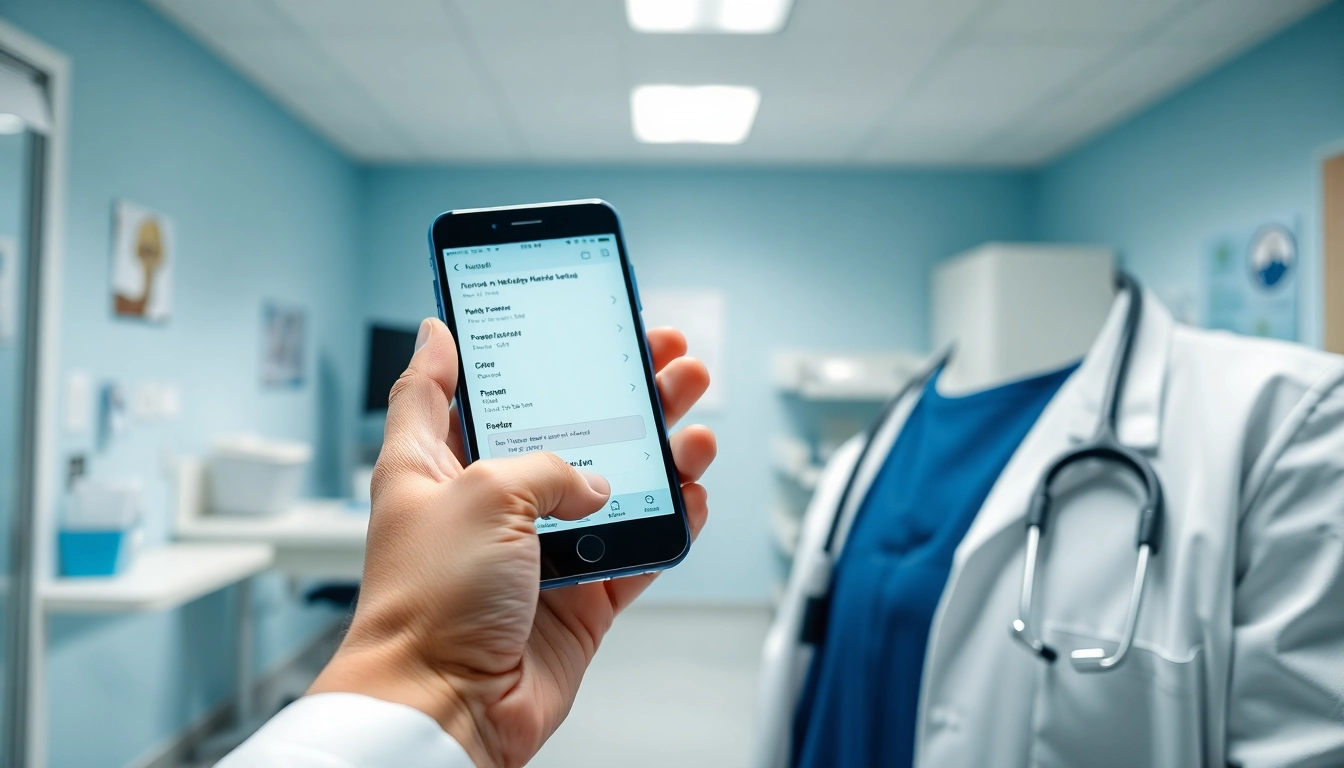Understanding Eprescription Apps for Android
What Are Eprescription Apps?
Eprescription apps are digital platforms designed to facilitate the electronic creation, transmission, and management of medical prescriptions. These applications allow healthcare providers to generate prescriptions directly from their mobile devices, ensuring improved accuracy and efficiency in the prescribing process. By utilizing e-prescribing technologies, practitioners can replace traditional paper-based prescribing methods, which often lead to errors and miscommunication.
Essentially, these apps streamline the prescription workflow between doctors, pharmacies, and patients, promoting better medication management and patient care. There are numerous eprescription apps for android that cater to the evolving needs of healthcare providers, enhancing their ability to offer precise and timely treatments.
The Importance of Digital Prescription Management
The transition from paper prescriptions to digital solutions marks a transformative shift in healthcare delivery. Digital prescription management significantly reduces the likelihood of errors that stem from illegible handwriting or misunderstanding dosage instructions, thus safeguarding patient safety. Moreover, these apps allow for easier tracking and monitoring of prescribed medications, enabling healthcare providers to oversee patient compliance and make timely adjustments if required.
Additionally, e-prescribing fosters communication among healthcare stakeholders. Doctors can send prescriptions directly to pharmacies electronically, minimizing the chance of lost or delayed handwritten prescriptions. This efficiency not only expedites medication access for patients but also shortens wait times at pharmacies, enhancing the overall patient experience.
Key Features to Look For in Eprescription Apps for Android
When choosing an eprescription app, several key features should be prioritized to ensure optimal functioning and usability:
- User-Friendly Interface: A straightforward and intuitive interface is fundamental for healthcare professionals who may not be tech-savvy. The app should facilitate easy navigation and quick access to essential features.
- Prescription Management: The app must enable the creation, editing, and management of prescriptions easily, allowing for accurate dosage and medication details.
- Pharmacy Integration: Seamless integration with local pharmacies ensures that prescriptions can be electronically transmitted, making it easier for patients to pick up their medications without delays.
- Medication History Tracking: Keeping a record of previous prescriptions is crucial for monitoring patients’ ongoing care and medication adherence.
- Compliance and Security Features: Given the sensitive nature of prescription management, robust security measures and compliance with regulations (such as HIPAA) are imperative.
- Technical Support: Reliable customer service and support can significantly enhance user experience, helping providers resolve issues quickly.
Benefits of Using Eprescription Apps for Android
Improved Workflow for Healthcare Providers
One of the most significant advantages of utilizing eprescription apps is the improved workflow for healthcare providers. With the ability to generate and send prescriptions in a matter of clicks, healthcare professionals can devote more time to patient care rather than administrative tasks. This increased efficiency not only helps reduce practitioner burnout but also promotes a healthier work environment.
Studies indicate that the improved workflow associated with e-prescribing can lead to faster patient throughput. As healthcare providers can focus on direct patient interactions rather than paperwork, the quality of care also tends to improve, ultimately benefiting patient outcomes.
Enhancing Patient Medication Adherence
Medication adherence is crucial for the successful management of chronic conditions. Eprescription apps enhance adherence by ensuring that patients receive the right medications at the right times. These applications often come with features that allow providers to send refill reminders, track adherence patterns, and intervene when necessary to improve compliance.
Additionally, some apps offer patient education resources that inform individuals about their medications, including potential side effects, dosages, and interactions with other drugs. By empowering patients with knowledge, these apps foster better health literacy and encourage adherence.
Reducing Prescription Errors and Miscommunication
Prescription errors can have dire consequences for patient safety. Eprescription apps significantly reduce the risk of these errors by eliminating issues associated with handwritten prescriptions, such as illegibility and misinterpretation. With standardized fields for entering information, healthcare providers can ensure that their prescriptions are clear and accurate, which decreases the chances of medication errors.
Furthermore, these apps often come equipped with clinical decision support systems that alert providers about drug interactions, allergies, and contraindications. This functionality helps safeguard against miscommunication, providing a secondary layer of verification before medications are dispensed.
Choosing the Right Eprescription App for Android
Evaluating App Functionality and Usability
Choosing the right eprescription app for Android requires thorough evaluation. Start by considering the app’s functionality: Does it have all the features you need for your practice? Tools for tracking history, billing, and patient communication can be significant advantages.
Usability should also be a priority. Conducting a trial run with a demo version can help assess whether the app meets user expectations. A cluttered interface or lengthy navigation processes can lead to frustration, ultimately affecting productivity and care quality.
Considering State Regulations and Compliance
Healthcare regulations vary significantly from state to state, impacting how prescriptions must be managed. When selecting an eprescription app, ensure that it complies with the specific regulations governing your location. Understanding the legal frameworks surrounding e-prescribing is critical for maintaining compliance and avoiding potential penalties.
Furthermore, look for features in the app that assist with compliance, such as two-factor authentication and electronic prescription tracking systems that ensure security and prevent fraud.
Customer Reviews and Ratings Analysis
Analyzing customer reviews and ratings can provide valuable insights into an eprescription app’s effectiveness. Seek platforms that aggregate user feedback, focusing on both the positive and negative experiences expressed by practitioners. Factors like customer service responsiveness, app update frequency, and bug resolution rates can significantly impact user satisfaction.
Don’t hesitate to reach out directly to other users or forums for firsthand accounts and tips. This type of informal research can paint a clearer picture of what to expect from the app’s day-to-day usage.
Integrating Eprescription Apps with Existing Systems
Syncing with EHR Systems
For maximum efficiency, it is essential to integrate eprescription apps with existing electronic health record (EHR) systems. This integration allows for seamless data transfer between platforms, maintaining accuracy across all patient records. Data synchronization minimizes duplication and ensures that healthcare providers have up-to-date information readily available.
Before implementing a new eprescription app, evaluate whether it supports easy EHR integration. Working with IT specialists during the rollout phase can mitigate common integration challenges, ensuring a smoother transition for all users.
Training Staff for Seamless Adoption
Once an eprescription app has been chosen, staff training is critical for successful implementation. Even the most user-friendly applications require some acclimation. Organizing hands-on training sessions to familiarize staff with the app’s capabilities can drastically improve adoption rates. Providing resources like quick reference guides or access to support can also empower employees to feel confident in using the technology.
Monitoring and Evaluating Performance Metrics
Continuous assessment of the eprescription app’s performance is vital to ensuring that it meets the needs of healthcare providers and patients alike. Metrics like prescription errors, patient adherence rates, and user satisfaction scores can serve as benchmarks for performance assessment.
Regularly collecting this data allows healthcare practices to pinpoint areas needing improvement, enabling providers to maximize the effectiveness of their digital prescription management systems.
Future Trends in Eprescription Apps for Android
Emerging Technologies Transforming Eprescribing
The healthcare landscape is continuously evolving, and emerging technologies promise to reshape e-prescribing. Innovations such as artificial intelligence (AI) and machine learning are beginning to play a role in predicting prescribing patterns and identifying potential medication interactions before they occur.
Furthermore, features like voice recognition and natural language processing are simplifying the prescribing process. As these technologies mature, the potential for enhanced accuracy and efficiency will grow, ultimately improving patient outcomes through better medication management.
Potential Regulatory Changes
As the use of e-prescribing becomes more widespread, governments are likely to revise existing regulations or introduce new mandates to enhance patient safety and streamline processes. Staying informed about potential shifts in regulatory frameworks is essential for healthcare providers. Adapting to these changes quickly will ensure compliance and maintain the integrity of patient care.
The Rise of Telehealth and Its Impact on Eprescription
The global pandemic accelerated the adoption of telehealth services, and this trend is unlikely to reverse. As telehealth becomes more prevalent, the role of e-prescription apps will continue to grow. Patients can consult with healthcare providers virtually and receive their prescriptions digitally, bridging the gap between healthcare delivery and access.
Integrating telehealth features, such as virtual consultations, within eprescription apps can enhance the overall patient experience and promote health outcomes. As more patients become accustomed to receiving care remotely, the demand for comprehensive digital solutions for prescription management will only increase.



